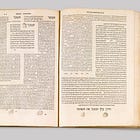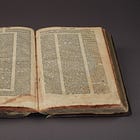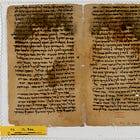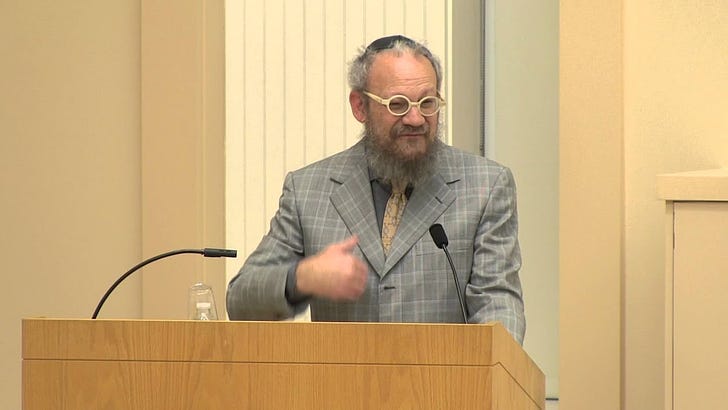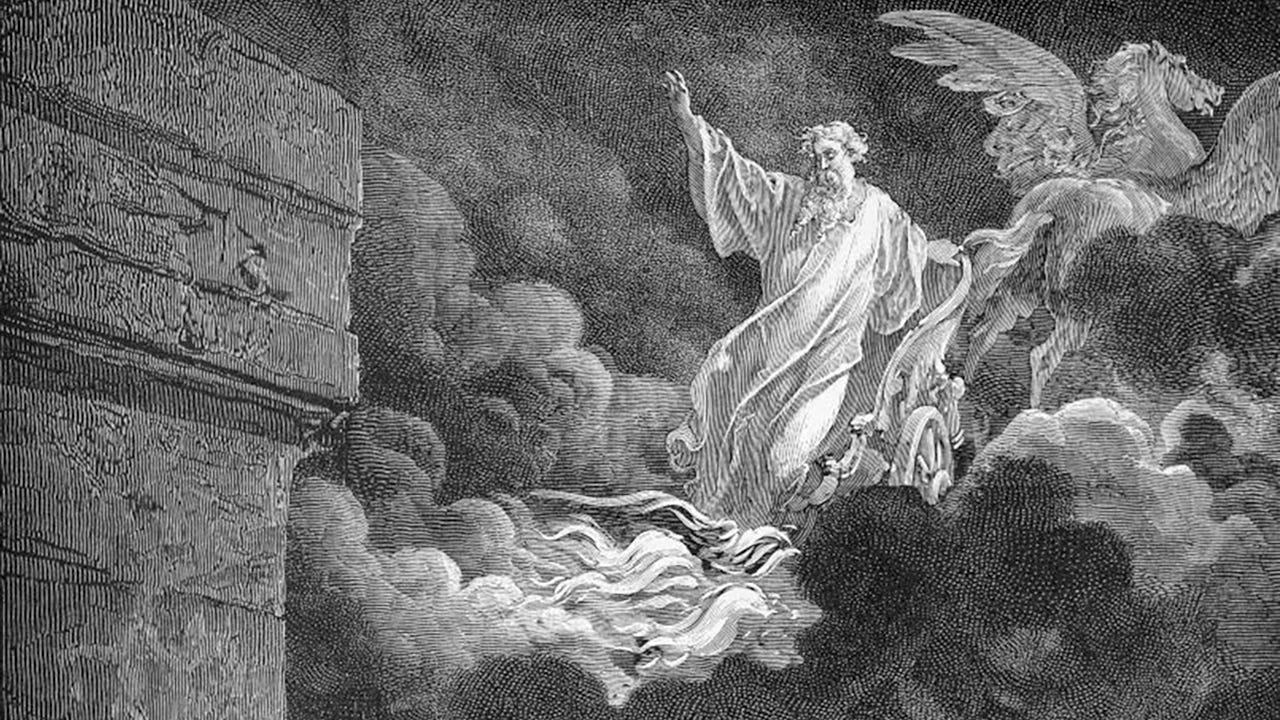On How and How Not to Read The Talmud (VII)
The Penultimate post, which has the juicy stuff you've been waiting for, where we return to Richard Carrier and check his sources and his assessment of sources, including Mitchell and Boyarin
Greetings, we are, finally, almost done. Only one more post to go. This is where we get deep into the weeds (and those weeds extend massive roots into the footnotes, which are very dense and academic, so don’t worry if they’re not your cup of tea). I have spent an inordinate amount of time checking and double-checking material, requesting scans of out of print stuff in library stacks, comparing editions and the like, and those footnotes are the result of that. As such, the footnotes here are extensive, and rather dense, though they are supplementary to the primary points. They will not be accessible to everyone. But that such extensive footnotes are warranted, and what one can glean from them even without background knowledge should be indicative of something, I hope. I hope the body text doesn’t descend too far into the same technicality, but I am a little indignant about some of the things proposed here. But such is life. Hopefully the final installment will be next week, but I’m heading into exams, and spent far too long trying, and failing, to find an old edition for said notes. But here we go.
previous installments (recommended to read prior to this) are here:
There are three further implications that bear consideration.
Firstly, as should hopefully be clear from the extensive treatment I have given, the idea that there is any singular messianic ideology that involves conflation of the elements of a) a final redemptive eschatological messiah who b) suffers and dies, only to c) rise again is present in any of these passages, or simply one step away from them can be put to rest. This is simply not the case. In fact, we seem to have evidence of a complex development of two alternative, distinctly non-Christian Messianic systems, and attempts to harmonize them.
Secondly, if any of those elements, independently, are present in the Bavli, their continuity from an earlier period, much less a pre-Rabbinic one, cannot be demonstrated. The lack of attestation in the early rabbinic material is striking, and just above we have seen them changing and developing in marked ways. The evidence of a chain of transmission is entirely absent, and the simplest explanation of their presence in the late material is that of exegetical creativity in response to a clearly present and well-documented Christian influence. Just as there is extensive Christian engagement with Jewish thought across these centuries (much of it couched in oppositional polemic such as that of Justin Martyr and Origen) there is extensive engagement with Christian thought in the Rabbinic literature. A chain of independent, unconditioned transmission as suggested by Carrier cannot be hypothesized based on the surveyed material that survives, and such a proposal would have to account for both the clear process of development and the abundant evidence of Christian influence that has been examined – much of which is present in the framing material of the only passages that contain these kinds of ideas. If there were counter-evidence it would have to be presented, and it has not.
This point should be abundantly clear, and cannot be emphasised enough: To argue that this Talmudic material, compiled half a millennium later, reflects a first century environment appears to me to be exponentially more difficult than to argue for the historicity of the Gospel of John, much less the Synoptic Gospels that Carrier himself believes have little-to-no historical material contained within them.
Thirdly, the presence of any of these ideas in even pre-first-century non-Christian material is highly controversial. That its existence is claimed primarily by those are predisposed to its presence, and for whom claiming continuity appears desirable predisposes me, in turn, toward scepticism. I am by no means an expert on this and thus will be cursory, but on this point Daniel Boyarin’s caution is worth emphasising, as he states, in one of the final footnotes to his book The Jewish Gospels, regarding the equation of the suffering servant with the messiah:
I am not claiming that therefore the followers of Jesus did not originate this particular midrash, rather, if and when they did so, the hermeneutical practice they were engaged in be spoke in itself the "Jewishness" of their religious thinking and imagination.1 (emphasis mine).
Carrier seems to miss this qualification – he is being careful, and hedging because he knows he cannot demonstrate the pre-existence of concepts so opts rather for a pre-existing hermeneutic. And Boyarin indeed is dealing almost exclusively with Christian and post-Christian Jewish texts in the book.
Further, as I am not qualified to address the Qumran evidence, I will defer to both Kipp Davis and the premier scholar of Second Temple Judaism John J Collins, the latter of whom writes, after a substantial treatment of the scrolls material and secondary literature on the subject:
The alleged allusions to a suffering messiah in the scrolls disappear under examination. The Christian belief in such a figure, and discovery of prophecies relation to him, surely arose in retrospect after the passion and death of Jesus of Nazareth. There is no evidence that anyone in first-century Judaism expected such a figure, either in fulfilment of Isaiah 53 or on any other basis.2
Following this is a discussion of a similar selection of passages from the Bavli (our passage from Sukkah, and Sanh. 98a). The treatment is somewhat cursory but reaches much the same conclusion: that these passages do not reflect the same unified conceptual matrix as that which cemented in the Christian tradition, and that these are also later traditions. For anyone interested in these topics Collins’ analysis both in this excursus and the book it is contained in is indispensable, and its absence from the bibliography of OTHOJ is striking, as one would expect it to be one of the first books consulted on this topic. Carrier’s book, as far as I have surveyed, also lacks is anything resembling the kind of treatment of scholarship presented in that excursus, describing what is argued and then presenting counterevidence, textual analysis and additional material that is overlooked. It is difficult, often, to tell what precisely Carrier is citing someone for, and what he may agree with or disagree with, as his engagement with scholars like Boyarin is often limited to a footnote, citation, and some page numbers. There is little quotation of or substantial engagement with their work, much less with anyone presenting substantial, point-by-point treatments of secondary sources who reach different conclusions to him, including Boyarin, who he himself cites in the previous footnote to this treatment.
Likewise, there are no direct quotations from the Bavli material, only glosses that are, as we have demonstrated, highly inaccurate. I feel I have done the work to thoroughly demonstrate this point. This is a marked departure from any scholarly literature dealing with this material that I have read. The standard for presenting material like this is direct quotations followed by interpretation, and elaboration how one gets from the text to the interpretation of it. Even in survey literature at least limited quotation is the norm, and extensive references to more thorough treatments, of which, on this subject, Carrier’s book provides none at all. He doesn’t even cite whatever translations he is presumably working from. These complex passages, part of a long and intricate chain of exegetical creativity, spanning centuries, are flattened into a simulacrum of Christianity – the opposition to which constitutes one of the major contributing factors to the ornate creativity evidenced in these texts. If the treatment of other sources is at all similar to this, it should be regarded with the highest degree of scepticism.
One final note worth making is regarding Carrier’s citation of scholarship on this topic on his blog. He has posted extensively in response to Kipp Davis’ criticisms, including many citations of scholars. I wish to discuss a single element of this, in relation to the rabbinic corpus.
In his post-OTHOJ defence of the supposed antiquity of the dying messiah tradition he cites a paper by David C Mitchell (who also has self-published a book on the subject) called “Rabbi Dosa and the Rabbis Differ”.3 Carrier also describes Mitchell as having “received wide praise among highly qualified peers” and presents his research as if it were a widely accepted scholastic conclusion. Contra Carrier’s claim that they are “professors of Jewish studies”, of the cited scholars praising him, only Avery-Peck has any publishing history on the Rabbinic literature, the rest are biblical scholars. Hebrew bible and Rabbinic literature (much less “Jewish studies”) are different fields. Note that Mitchell’s PHD is in the former, not the latter. Then, in the following paragraph, he cites Daniel Boyarin again, an actual Rabbinic scholar, also apparently in aid of the pre-Christian existence of the pre-Christian dying Messiah. Boyarin’s agnostic conclusion on this is given above, the footnote that I have quoted is also quoted in full in the summary of Boyarin’s views that Carrier provides a link to.
However, this is not where the major problem is, which is Boyarin’s assessment of Mitchell’s reading in the aforementioned paper. In notes to the very pages Carrier cites,4 Boyarin says:
This alternative Messiah, known only from the Babylonian Talmud and later texts, seems precisely to represent a sort of apologetic way of avoiding the implications of earlier traditions within which the Messiah suffers and/or is slain, such as is clear from the PT [i.e. Yerushalmi] version of this tradition. David C. Mitchell […] could hardly be more wrong in his interpretation of the rabbinic material. He insists that the Palestinian Talmudic text is tannaitic [i.e. 1-2st Century], notwithstanding the fact that it says "two Amoraim" explicitly [i.e. 3rd to 5th Century]; he considers the Babylonian Talmudic text primary and the Palestinian one secondary [note: the opposite is true, both in terms of dependency and chronology], and he seems to think that if the saying is quoted in the name of Rabbi Dosa [note: a Rabbi attested in the 2nd C], that means that it is something that actually was said by a figure who lived while the Temple still stood [a probably unnecessary note: it was destroyed in 70CE]. Finally, he insists that a text cited explicitly as amoraic must be tannaitic simply because its diction is Hebrew and all Hebrew texts, eo ipso, are Palestinian and before A.D 200 [note: this places the at-earliest 4th C Mishna Sotah coda before this, which, bar a couple of sentences, is in Hebrew], which further reveals his innocence of rabbinic textual knowledge. I know of no evidence for a Messiah the son of Joseph before late antiquity.5
Note that many of these exact issues are what I have elaborated in the extensive readings I have given of the passages thus cited. On this basis I would be beyond hesitant to trust a self-published book by someone whose primary interests appear to be the Bible and liturgical music, and whose interest in messianism seems devoutly and apologetically Christian. I would far rather trust the authority who has extensive publications, qualifications and has held esteemed teaching positions in Rabbinic literature, such as Daniel Boyarin.
Having read the paper in question, Boyarin seems correct, as his argument for dating this tradition to before the destruction of the Temple appears to be based on the use of Hebrew, used throughout the Rabbinic period and into the Middle Ages, including in very late Midrashim he himself cites.6 This would appear to date most of the Mishnah, including the 4th Century ending of Sotah 9:15 and other demonstrably late material before the 3rd Century, and would also probably place the amoraic, Babylonian-educated Rabbi Asi, also quoted in this passage, in Tannaitic Palestine. He also seems unaware of the substantial problematization of dating at this granular a level even by dialect, the most basic of which is dialectical variance is much geographic as it is temporal, and dialects can be, and are, mimicked as literary style.7 The claims he makes extend further than even the historical claims the Talmud makes of itself, while ignoring the context in which the passages in question originate, which is clearly halachic, in favour of theological biblical exegesis. By misidentifying the genre of the discussion, he produces a misinterpretation.8 Similarly, he equivocates on the translation of Amoraim,9 while fixating on the introduction of the previous Tosefta as Tannaitic, seemingly without consideration of the fact that the words involved, and the particular contexts they are deployed in, אמ״ר (amar) and תנ״א (tana) are the sources of the names of the generation, and thus accepting one as grounds for dating part of the passage necessitates accepting the other (or, more technically, the other concurrent with the absence of the former) as the same10 – if one rejects in principle the formulae for introducing statements as determining their age, then the argument defeats itself: if the former just means “spoke” or “interpreted” (though here it is a noun, a form that doesn’t occur in the Tannaitic collections of the Mishnah and Tosefta), doesn’t the latter simply mean “taught” or “related”? Particularly when those introductory statements open separate components within the passage (there is a discrete citation of Tosefta Sukkah 4:1 embedded within the Gemara). He is probably correct that the first part is Tannaitic, as it is preserved in Tosefta: but the words of the “Two amoraim” are not and are not introduced as Tannaitic – and neither is Rabbi Dosa in the Bavli, nor the Rabbis: פליגי בה רבי דוסא ורבנן חד אמר... וחד אמר. There is not תנ״א here, so no grounds for tannaitic attribution – indeed in between the Tosefta and this discussion in the Bavli is the explanation offered by the Amora Rav. To argue this is to argue that both the earlier compositions, i.e. the Tosefta and the Yerushalmi, are fundamentally corrupt and incomplete, inaccurately recording a discussion these documents exist for the purpose of recording, which is only preserved in a comprehensible form in the Bavli, with no concrete evidential reason given for that.
Likewise, his discussion of Midrash presents problems, as his dating of their contents is entirely dependent on the proposed linguistic dating of this passage (they, including medieval Midrashim in Hebrew, do not get the same treatment, nor are the proffered as evidence for the continuity of Hebrew composition). Further, he asserts a causal connection, entailing atonement, between the death of this Messiah and the slaying of the Yezter Hara, when these two ideas are given as competing interpretations for the verse from Zechariah.11 This idea is completely absent from the text. His citations for many exegetical points are from the 19th Century.12 That this death is that of a figure who is himself metonymically representative of Christian messianic claims (though also refuting attribution of Davidic lineage) strongly implies that his death being necessary for the end of sin, and, in the Bavli, his absence from descriptions of the post-resurrection messianic age, may be wholly a Rabbinic response to said claims. I strongly suggest that any attempt to recuperate this motif as somehow shared between Christianity and Judaism appears primarily to be the product of contemporary interreligious apologia.13 This social goal of reconciliation is admirable, but the method is regrettably ahistorical.
And, further, even if one were to accept Mitchell’s rationale for dating this specific text, doing so would undercut the purported historical content of the Sanhedrin passages as they are in Aramaic (bar Biblical citations) – the passage on 93b is entirely (including the explanation that the verse describes smell, which is a translation from the Hebrew of Isaiah), and the statement about the leper in 98b is, as is the passage on 98a discussed by Boyarin, dated as the earliest Rabbinic attestation of connection to the suffering servant by Himmelfarb, and uncited by Carrier.
It is incredibly bewildering that this is somehow convincing to someone like Carrier, and atheist so ardent that he accuses other atheists of being crypto-Christian apologists, when this work of Mitchell’s appears clearly to be part of an elaborate project in Theological Christology, as evident both from its systematic nature (Mashiach ben Yosef can be traced back from the Bavli through the Dead Sea Scrolls and First Enoch all the way back to the Psalter) and being written by an author who is a self-professed amateur theologian (inferred by way of his being a professional music director) who describes himself primarily on those terms. And one who is so convinced of the reality of Jesus that he traces Jesus back to the Melchizedek who Abraham meets in Genesis 14. Mitchell undeniably knows his material, but uses this knowledge toward a very particular end. How on earth Carrier is more convinced by a writer like this than the Atheist scholars he so frequently calls Christian, as an insult, is beyond me. I think this demonstrates something fundamental about his ability to assess scholarship, as, as one would expect given his admitted lack of the requisite languages, he absolutely fails to grasp the concerted and fundamental methodological problems in Mitchell’s work.
next post:
Boyarin, The Jewish Gospels : the story of the Jewish Christ, 190 n26. Note that this is the footnote to the paragraph quoted in Carrier’s video response to Davis, and McGrath’s discussion of the blog post in question. Reading footnotes that qualify claims is an important part of evaluating said claims. And, if anyone looked up that page in Boyarin’s book, they, hopefully, would find this exact footnote. That “Christianity grew entirely out of Jewish soil,” as Hengel asserts and Boyarin agrees here, does not entail that “this midrash” necessarily exists prior to Christianity.
John J. Collins, The scepter and the Star : the Messiahs of the Dead Sea Scrolls and Other Ancient Literature, 1st ed., The Anchor Bible reference library, (New York: Doubleday, 1995), 126.
Mitchell, "Rabbi Dosa and the Rabbis Differ: Messiah ben Joseph in the Babylonian Talmud."
Carrier, On the historicity of Jesus: Why We Might Have Reason For Doubt, 73 n29. The citation is Boyarin, The Jewish Gospels : the story of the Jewish Christ, 129-56. The note in question is n19, in Boyarin, 153.
Boyarin, The Jewish Gospels : the story of the Jewish Christ, 188n19.
For but two, Peskita Rabbati and Seder Eliyahu Rabbah, the former compiled in the 9th Century and the latter probably 11th.
This is a perhaps unnecessarily elaborate rebuttal of Mitchell’s point, which appears to be a conflation of the dialect of Mishnaic Hebrew (supported by a citation from E.Y. Kutscher), with the Hebrew language itself, as he writes, firstly: “The Hebrew passages represent oral traditions deriving from the land of Israel in the Tannaitic period before 200 C.E.” (77), followed by “His [J Klausner’s, from his 1956 book on messianic thought] suggestion is immediately countered by the fact that this text, like its Bavli parallel, is a Hebrew tradition in an Aramaic frame, suggesting again a Tannaitic origin” (82). Both the Yerushalmi and Bavli texts being tannaitic (and Palestinian!) fails to account for his asserted priority of the Bavli over the Yerushalmi (82-3), as both, being in Hebrew, would on this basis date to the same time and the same place, when the passages are clearly in different dialects (for but one feature, compare the use of ש[ל-] throughout the TY vs על in the BT in the Hebrew framing of the dispute, and those very dialectical markers point to the Yerushalmi’s characteristically terse MH vs the Bavli’s more polished, literary Hebrew, closer to that found in medieval texts). He is further unable to account for the differences between the content of the two texts, except by the extremely uncertain pondering “Did the Yerushalmi redactor not know the full version of a tradition that originated in the land of Israel? Perhaps. But if he was a disciple of the “rabbis” of B. Suk. 52a, he may have known the tradition well enough but liked it so little that he was unwilling to transmit it intact or grant it the name of the revered Dosa” (83). This dismisses the markers clearly implying dependency going in the opposite direction and, based on an assumed prior tradition containing the entire exegesis, disallows the possibility of the longer passage being the result of even Amoraic creativity without any consideration. This assumption will necessarily lead to the reached conclusion. Further, that Hebrew can date texts (and locate them in Palestine!) would place significant sections of the two Talmudim, including clearly later material , to the first through early third centuries – alongside the 4th Century additions Mishna Sotah that has been discussed (note that the Kingdom converting to minut is also cited in the names of various Tannaim). The assertion on 115 that a Baraita must have a tannaitic, Palestinian origin is refuted by the Bavli citation of the Sotah coda passages as such, see n20 (IV 1) above. For but one example of modern scholarship on ancient socio-linguistics, see Uri Mor, "Two Case Studies of Linguistic Variation in Mishnaic Hebrew," Journal of Semitic studies 65, no. 1 (2020), https://doi.org/10.1093/jss/fgz043. 117-136. Note also the clear evidence presented for spoken Hebrew in the Amoraic period, surviving in different dialectics in Palestine and Babylonia.
This is an elementary type of error, which should be familiar to any student of biblical literature. It also betrays a certain kind of bias, as law is primarily Jewish concern. However, in this context it is an easy error to make, as the Bavli passage is traditionally identified as Aggadah – non-legal discourse – however the characteristic nature of Aggadah is that it exists within the frame of halachic discourse, the primary concern of both Talmudim. Aggadah is often used to illustrate a halachic point, and thus the division is not so clear cut. In this instance, this passage is itself the justification for the segregation of the sexes in traditional orthodoxy. Another good example is possibly the most well-known Talmudic story, the Oven of Akhnai in Bava Metzia 59b: in that case the entire reason for the introduction of the story is to make a point about the consequences of verbal mistreatment, and why there is a commandment against it. See the parallel from this statement on the previous folio with this, that closes the story. However, as we have seen, the halachic concern is clearly primary (see the previous discussion of this passage), and this is the reason for the absence of extensive exegesis in the Yerushalmi – that is unnecessary for the resolution of the halachic matter at hand, and only becomes important for the later Bavli, as the prior halachic decision has already been taken up and become culturally normative.
Mitchell, "Rabbi Dosa and the Rabbis Differ: Messiah ben Joseph in the Babylonian Talmud." 82-3. This equivocation has no philological grounds as the word is not used in this this way as a noun in the Tannaitic Mishnah and Tosefta. Indeed, the primary use is in the phrase במה דברים אמורים/ן – “when are these things said?” meaning, roughly, “in what case does this apply?” – אמורים/ן is here not a noun but a participle modifying דברים, words/things. It is not used as a noun to describe a transmitted interpretation, and the use to designate an interpreter, much less an interpretation, is rare prior to the Talmudim – the use proposed by Mitchell appears without precedent, at least to my knowledge. And, if it were “an interpretation” that appears to rule out its transmission from the earlier period, as it appears it would necessarily entail a novel explanation of the previous halachic proof offered. I would challenge anyone advocating for such a reading to produce another example of this usage that can be dated as early as Mitchell is proposing. Or an example of this usage at all, while explaining the use of this exact phrasing (תרין אמורין), to introduce named Amoraim in other places in Yerushalmi, such as Berakhot 1:1:18 and Moed Katan 1:7:6.
The source of the distinction is this diction in the Talmudim, the traditional opinion being that the redactors differentiate between material they consider earlier - and thus being the repetition of untainted tradition from when the temple stood, introduced with ת”נא, vesting it with authority, vs the later explanations, without said introduction, instead only ever “said”, אמ״ר. Much of the time the former lines up with Rabbis dating prior to two generations later than Yehudah Hanasi (which is the latest that opinions are cited in the Mishnah and Tosefta, and the bulk of the Halachic Midrashim), but this is not always accurate, and misattribution can be demonstrated in some places, as we have seen.
Mitchell, "Rabbi Dosa and the Rabbis Differ”, 90. If there is any connection between the two, the Bavli’s elision of this figure in the final messianic age as per the citation of Micah may suggest a causal link – and that this is the reason for his absence from the final schema elaborating Micah 5:4, implying he is not resurrected. This is a tentative reading, but makes more sense than that proposed by Mitchell, which appears to be based on the extrapolation of Christian concerns. The only clear evidence that this belief was ever held (provided in another paper, “Messiah ben Joseph: A Sacrifice of Atonement for Israel”. Review of Rabbinic Judaism 10.1 (2007) pp. 77-94, linked on his blog) is from extremely late texts such as the 19th Century kabbalist Elijah Benamozegh and the Medieval Zohar (13th C), both renowned for highly developed engagement with Christian thought. The other evidence provided is likewise medieval, displays Christian influence, or the conclusions reached display the same conceptual projection onto the texts.
Mitchell, "Rabbi Dosa and the Rabbis Differ: Messiah ben Joseph in the Babylonian Talmud." 79n4, 80nn7 & n9, 85n28, 87n35, 88n38, and there is much from the medieval period and the early 20th Century. His references to texts from 1970 onward are almost exclusively on the Dead Sea Scrolls, not the Rabbinic literature; I was unable to find a single citation of modern critical rabbinic scholarship in his notes. He also seems to be citing the first edition of Encyclopaedia Judaica, citing B. De Vries as stating that “there is no evidence that the phrase [תנו רבנן] is ever used for post-Tannaitic teachings” (80n7). DeVries’ adherence to the traditional model of attribution, and the insufficiency of this in the face of modern historical criticism, is noted by Charles Primus, "Benjamin Devries," in The Modern Study of the Mishnah, ed. Jacob Neusner (Leiden: Brill, 1973), that “he presupposes the validity of the conventional rabbinic view” and “thus invariably accepts the historicity of Tannaitic and Amoraic assertions” (243). The most recent edition, with a new article (“Baraitot” rather than the archaic “Baraithot”) informed by more current research, specifically describes the term תנ״א (and its derivative forms) introducing Amoraic Baraitot, and describes Baraitot that originate in Babylonia; and that the use of the term תנו רבנן may more properly be considered stylistic (the same material is introduced in different places with different formulas, it is simply one of several ways of introducing unattributed material as Baraita). Stephen G. Wald, "Baraita, Beraitot," in Encyclopaedia Judaica, ed. Michael Berenbaum and Fred Skolnik (Detroit, MI: Macmillan Reference USA, 2007), 124-128. This Wald article is in both the editions I consulted (the latest with additional updates, available online), but I was unfortunately unable to consult a first edition to verify Mitchell’s citation. This is not aided by bibliographies for his papers not being available online. Further, this is only used to introduce the initial Tosefta. If this tradition dates back to the time of the temple, why is it in neither Mishnah nor Tosefta? This is telling, whereas its presence here is not, as one of the structuring principles of the Bavli Sugya, as we have seen, is dialogue between Tannaitic and Amoraic statements – indeed this Sugya is introduced by the Amora Rav, and quotes many Amoraim, including the fourth century sage Abye. One cannot date the contents of a Sugya based on the citation of a Tosefta within it. Thus, the assumption that this is a record of a temporally bounded conversation is unfounded. For an example of these factors compare Suk 23b, Eruv 15b, Git 21b on one hand: דתניא ... ורבנן... with Kiddushin 5a: אמר אביי...רבא אמר – in the first, attributions for the same formal part of the argumentation (though phrased differently) are those are traditionally assumed to designated Tannaitic content, but in the 2nd these places in the argument are attributed to Rava (who brings the same objection) and Abaye (seeming to take the role of Yosei Hagelili, though presenting a different objection), not just Amoraim, but of the fourth Generation. See the discussion of these parallels in Halivni, Formation of the Babylonian Talmud. 30-4. Even if this is not accepted, that תנ״א is used to introduced 4th C material in Sanh. is more than enough to sink this assertion.
This may be charitable, as it could also be read as another manifestation of the same old supersessionism, as per Della Mirandola and Reuchlin and so on using the Kabbalah to “prove” Christianity, and thus Jewish ignorance of their own tradition, but I prefer to give the benefit of the doubt here.


